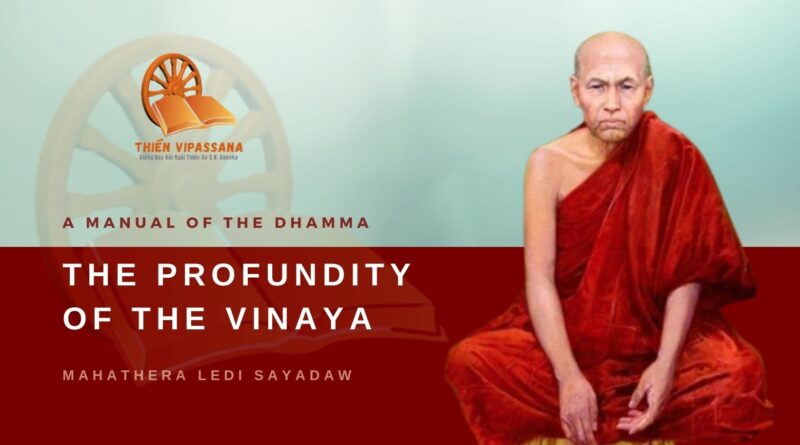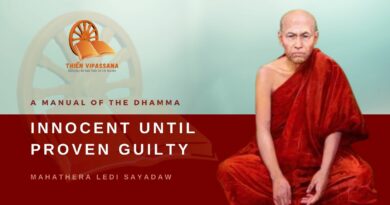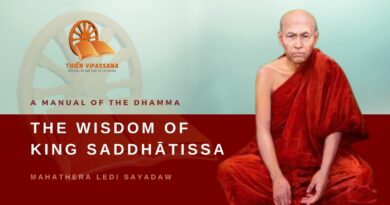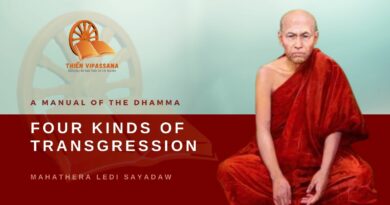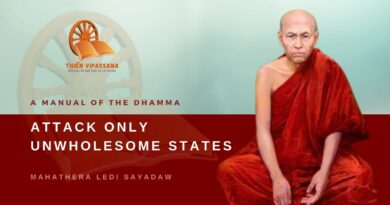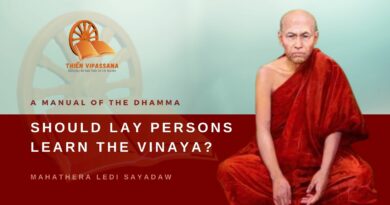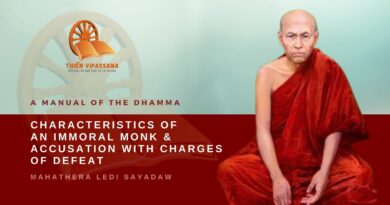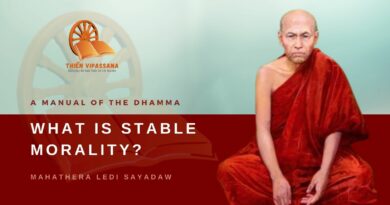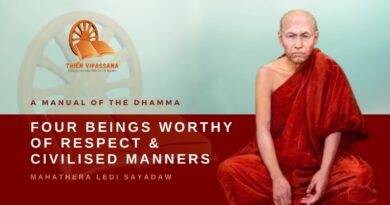The Profundity of the Vinaya
How deep and subtle the Vinaya is can be understood from the following examples. A lay person, even after eradicating all mental defilements and becoming an Arahant, has to pay respect to and worship an ordinary monk who still has all the mental defilements. This is because a monk enjoys that status by having followed the Vinaya procedure. An ordinary monk must not bow to an Arahant lay person as his own status is higher. The Arahant is still a lay person, while the other is a monk. If the two are compared on the basis of mental purity, this injunction seems unreasonable.
There is a vast difference between a lay Arahant and an ordinary monk. The former has personally achieved nibbāna so his heart is always pure, while the latter’s heart contains many defilements, so he is not free from the suffering of the lower realms. Yet a lay Arahant has to pay respect to a monk who is just an ordinary person. In the matter of status in the Buddha’s dispensation, an ordinary monk, being a member of the Saṅgha, is nobler than an Arahant who is just a lay person. Why does a lay Arahant have to worship an ordinary monk? It is due to the Vinaya proclaimed with the supreme authority of the Omniscient Buddha. One can therefore realise that the power of Vinaya is imponderable and boundless in scope and extent. The Buddha’s supreme power, immeasurable wholesome kamma, and omniscience manifest themselves in laying down these unique Vinaya rules. They have effects for every monk in the Buddha’s dispensation.
Another case should be mentioned in this connection. A junior monk by one hour [or one minute] must show respect to a senior. A junior monk who is an Arahant must pay respect to and worship a senior monk, who is still just an ordinary person. However senior she may be, an Arahant nun must worship a monk who is an ordinary person. Thus a Noble One of sixty rains must revere an ordinary monk. Why? These disciplines and modes of conduct are proclaimed by the Omniscient Buddha with his full authority, which is incomparable. They are known as “ānāpaññatti” — rules made by the supreme authority and boundless compassion of the Buddha.
This power that prevails in the Vinaya, and all other Dhamma powers of the Buddha are unique. The Vinaya and Dhamma take the place of the Buddha after his demise, as he declared in the Mahāparinibbāna Sutta:
“Ānanda, after I pass away the Dhamma and Vinaya I have proclaimed and prescribed will be your teachers.”
These prophetic words of the Buddha are profound, and their scope is boundless. So each of the millions of precepts undertaken by a monk during his ordination represents the Buddha himself. The prophetic words of the Buddha dwell in an ordained monk, whoever he may be.
A bhikkhu in this dispensation means a fully ordained monk who has fulfilled five factors: purity of the ordination procedure, purity of the group of monks, purity of the four formal recitations of kammavācā, purity of robes and bowl, and being a qualified candidate for full ordination. Once the ceremonies of taking the three refuges and formal recitations have been done, he instantly receives and undertakes the precepts. So we can say that nine billion Buddhas dwell in his person by the power of the Buddha and efficacy of the Vinaya. He is like a pagoda where the Buddha’s relics are enshrined.
Everyone should know that a pagoda, even if it is made of mud or sand, is a sacred object of worship because the Buddha’s relics are enshrined there. Due respect must be paid to the relics enshrined therein, which represent the Buddha, even if the pagoda is made of unworthy materials. If disrespect is shown even to this type of pagoda, one accumulates unwholesome kamma.
Even if the precincts of a pagoda are littered with dust, garbage, excrement, etc., the pagoda itself remains worthy of deep respect. So everyone should bow their heads in showing due respect to the relics, which are certainly worthy of honour. If one shows disrespect on seeing a pagoda with all sorts of rubbish nearby, one accumulates unwholesome kamma.
Similarly, an ordinary monk possesses millions of Buddhas in his person, though his mind is littered with thousands of mental defilements, like garbage near a pagoda. As long as a single Vinaya precept still exists in his person, he is entitled to be worshipped by a lay Arahant. The innumerable Vinaya precepts that exist in his person represent countless Buddhas. Though he is not free from Vinaya faults, he is like a pagoda. So a lay Arahant must revere him for this reason.
If devotees consider this matter carefully, they will realise the countless Vinaya rules observed by an ordinary monk. Moreover, they will appreciate and revere the power of the Buddha, who is fully entitled to proclaim Vinaya rules and regulations, and appropriate procedures for their purification. The commanding power of the Omniscient Buddha shows its greatest effects in the Saṅgha established by him. The power of the Vinaya is very profound, and is hard to understand by an ordinary devotee or uneducated layman. No one can fully fathom the significance of the Vinaya’s power.
Those laymen who have not yet realised nibbāna, should examine themselves to appreciate their own characteristics and status. If they reflect wisely they will willingly pay due respects to monks, even if they are shameless. All monks ordained properly in the Saṅgha under the authority of the Omniscient Buddha are entitled to receive worship and respect from the laity. So an intelligent layman will pay respect, give almsfood, and show deference, even to a shameless monk. As always, vigilance is essential for the profundity of the Buddha’s rules and their wide-ranging effects to be realised.
Even in an immoral monk, part of the Vinaya’s power and its effects still exist, though he has destroyed his undertaking of the precepts by committing an offence of defeat. If a scrupulous monk accuses him of defeat without proof, or at least circumstantial evidence, it is just like accusing an innocent monk. So one who accuses an immoral monk falls into a serious offence requiring a formal meeting of the Saṅgha. The Vinaya text and its Commentary explain this in detail.
Considering these facts in the Vinaya Piṭaka, one should appreciate the Vinaya’s power that still prevails in an immoral monk. Therefore, in dealing with an immoral monk, one must consider only the power of the Vinaya, focusing on the ordination procedure he has undergone. If these facts and powers of the Vinaya are known and understood, a lay person will be able to obtain the auspicious blessing of honouring the worthy as taught in the Maṅgala Sutta. One should focus one’s mind only on the marvellous power and significance of the Vinaya that prevails among the monks, even in the person of an immoral monk.
This is correct. An immoral monk retains the powerful influences of the Buddha, Dhamma, and Saṅgha even after his downfall. So these three sacred authorities become objects of worship in an immoral monk. Devotees should concentrate on these worthy things only. This proper relationship between the laity and monks accords with other teachings of the Buddha. Therein he exhorts the laity to honour the Dhamma by revering the wise, intelligent, and learned monks as they represent the knowledge of Dhamma, though they may lack some purity in their conduct. So a wise devotee objectively focuses his mind only on the monk’s learning and nothing else.
The case of lay people who do not know that a monk is immoral is interesting. Thinking him to be a scrupulous monk, they offer almsfood and pay him sincere respect. The object of their worship and respect is morality, yet this monk has no morality whatsoever. In this case they obtain suitable merits for their respectful attitude and reverential acts, though the monk, being without morality, cannot symbolise a scrupulous monk at all. So there is no “receiver”, as it were. Even in this case one should not hastily judge such offerings and respect as totally useless.
The reasons for this caution can be known from ancient precedents, like the case of King Saddhātissa in ancient Sri Lanka. Cases like this provide guidance for good deeds by the laity.

